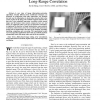Free Online Productivity Tools
i2Speak
i2Symbol
i2OCR
iTex2Img
iWeb2Print
iWeb2Shot
i2Type
iPdf2Split
iPdf2Merge
i2Bopomofo
i2Arabic
i2Style
i2Image
i2PDF
iLatex2Rtf
Sci2ools
TCSV
2002
2002
Image information restoration based on long-range correlation
A new class of image information-restoration algorithms virtually different from traditional techniques are proposed. In comparison with other approaches, our methods not only use the information in local areas, but also that in the remote regions in the image. The methods originate from the idea that there exists abundant long-range correlation within natural images and the human vision systems composed of our eyes and brains can sufficiently utilize such types of information redundancy to implement the functions of image interpretation, representation, restoration, enhancement, and error concealment. Our general approach can be summarized as five basic steps: fetching, searching, matching, competing, and recovering. The experimental results on several practical applications show that our methods perform substantially better than many other state-of-the-art methods.
| Added | 23 Dec 2010 |
| Updated | 23 Dec 2010 |
| Type | Journal |
| Year | 2002 |
| Where | TCSV |
| Authors | Dapeng Zhang, Zhou Wang |
Comments (0)

